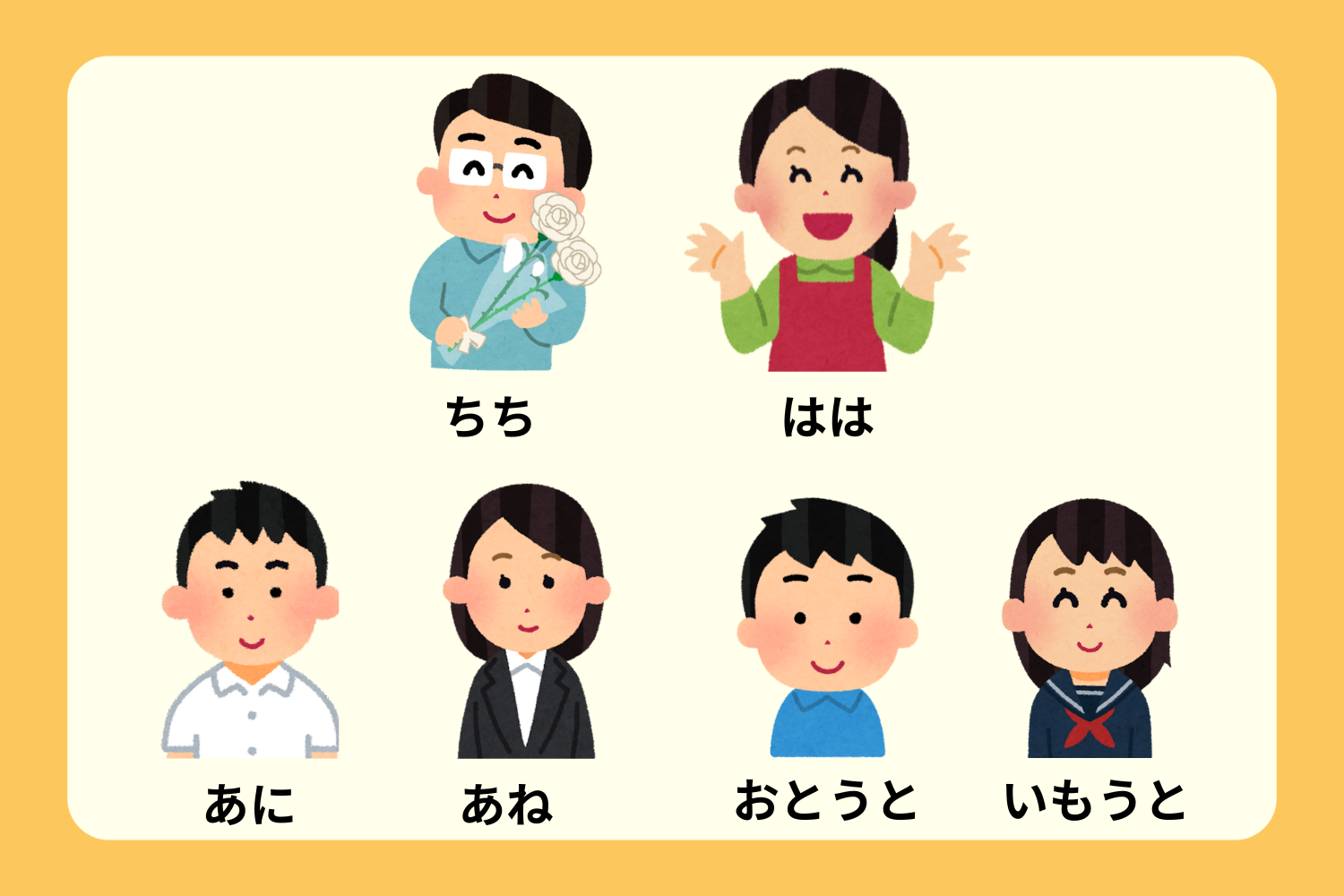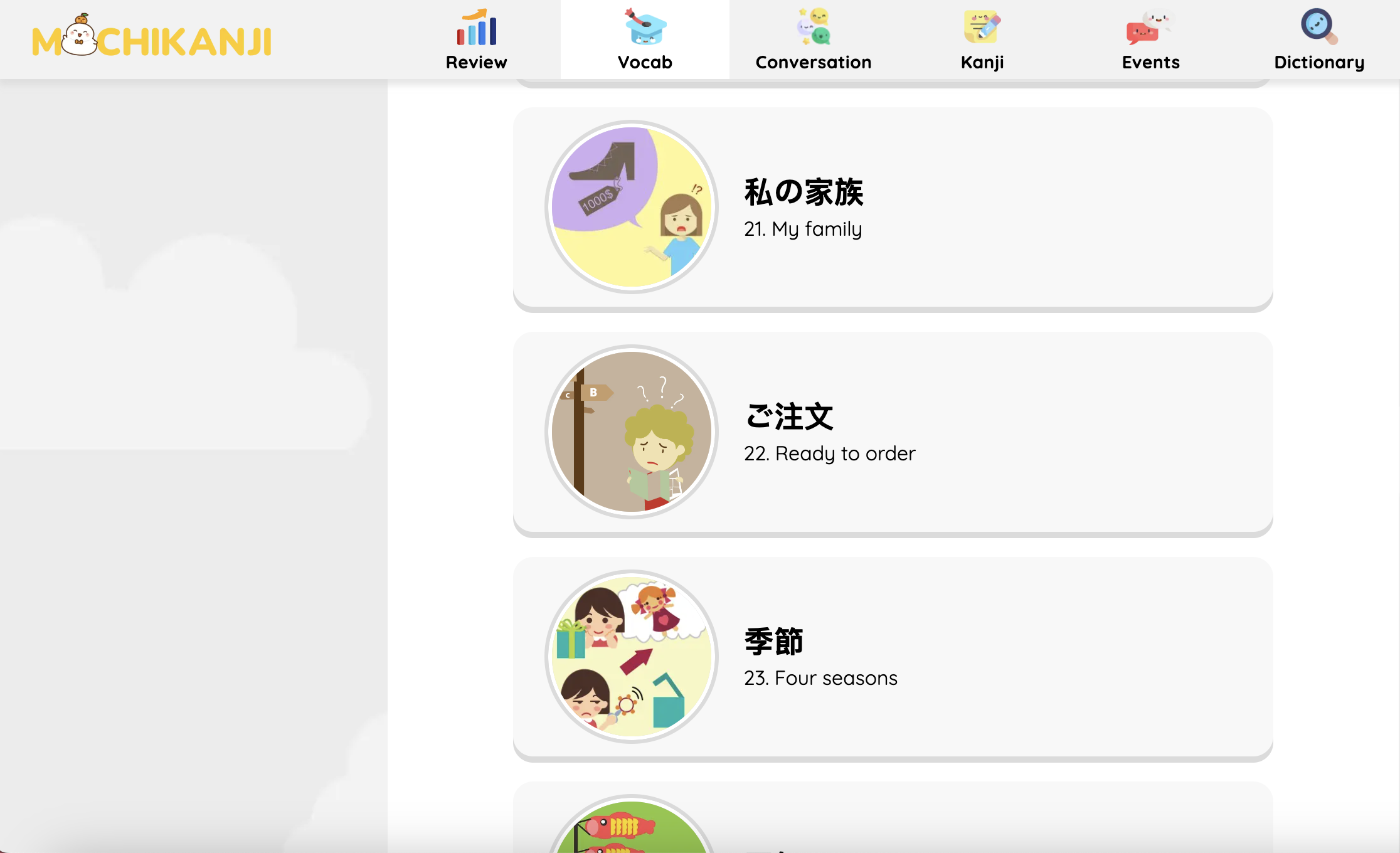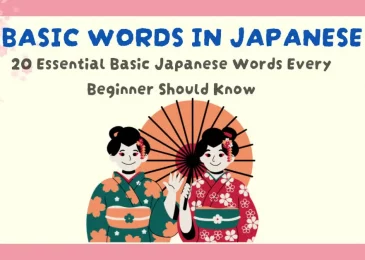Learning how to talk about family in Japanese goes beyond simple vocabulary; it provides insight into Japanese values, social structure, and respect for hierarchy. Japanese family terms are structured to show politeness, honor, and the nuances of familial roles. Knowing the right Japanese family vocabulary not only helps language learners communicate better but also demonstrates respect for Japanese cultural norms.
In this guide, we’ll explore the most essential Japanese words for family members, their usage in various contexts, and provide some cultural insights that affect these terms. Whether you’re just beginning your Japanese journey or enhancing your knowledge, this guide covers the fundamentals of family in Japanese.
Basic Japanese Family Vocabulary
Let’s start with basic family terms in Japanese used for immediate family members. Japanese language learners often encounter different words depending on formality, and the terms below are commonly used in everyday speech.
• Kazoku (家族) – Family
The general word for family. In Japanese, “Kazoku” includes parents, children, and immediate family members.
• Chichi (父) / Otosan (お父さん) – Father
Chichi is used when referring to one’s own father, especially in formal settings, while Otosan is more respectful and commonly used when addressing one’s father directly.
• Haha (母) / Okasan (お母さん) – Mother
Similarly, Haha is used when speaking formally about one’s own mother, while Okasan is more respectful and used when directly addressing or referring to someone else’s mother.
• Ani (兄) / Onii-san (お兄さん) – Older Brother
Ani is the term used formally for one’s older brother, while Onii-san is a respectful, familiar term used to address him directly.
• Ane (姉) / Onee-san (お姉さん) – Older Sister
Ane is used for formal references, while Onee-san is the direct and respectful form to address an older sister.
• Otouto (弟) – Younger Brother
Otouto is used to refer to a younger brother and does not typically require honorifics because of the inherent social hierarchy (younger siblings have lower status). However, adding “san” (e.g., Otouto-san) is sometimes done in very polite contexts.
• Imouto (妹) – Younger Sister
Similarly, Imouto is used for a younger sister. Adding “san” to Imouto is less common but may be used to show extra respect.
Each of these terms reflects the Japanese concept of respect within the family. It’s important to know when to use formal terms versus casual terms, as the incorrect usage can come across as overly familiar or impolite.
Extended Family Vocabulary in Japanese
Beyond immediate family, Japanese family terms include extended family members such as grandparents, aunts, uncles, and cousins. Here are some essential terms:
• Sofu (祖父) / Ojiisan (おじいさん) – Grandfather
Sofu is used when referring to one’s own grandfather, while Ojiisan is a more respectful form that can be used to address him directly or refer to someone else’s grandfather.
• Sobo (祖母) / Obaasan (おばあさん) – Grandmother
Sobo refers to one’s own grandmother, whereas Obaasan is a more familiar, respectful term for direct address or third-person reference.
• Ojisan (おじさん) – Uncle
This term can be used to refer to any uncle. Unlike direct family, Ojisan doesn’t have a formal equivalent, but honorifics may still apply based on context.
• Obasan (おばさん) – Aunt
Similar to Ojisan, Obasan is used for any aunt without a separate formal version.
• Itoko (いとこ) – Cousin
The term Itoko covers all cousins, regardless of gender or age, and does not require honorifics unless in a particularly formal setting.
• Mago (孫) – Grandchild
Mago is the word for grandchild. When addressing a specific grandchild, adding “-chan” (a term of endearment) is common in casual family settings.
These terms are helpful when discussing your extended family or talking about someone else’s family in a respectful manner.
Honorifics and Respectful Forms for Family Members
In Japanese, honorifics play an essential role in showing respect, especially within the family. Japanese family vocabulary changes based on the level of respect intended. Here’s how different honorifics work with family terms:
• -san (さん): Commonly used as a polite suffix and can be added to most family terms (e.g., Otosan).
• -sama (さま): A highly respectful honorific, used in very formal or ceremonial contexts.
• -chan (ちゃん): Often used as an endearing suffix for younger family members or children.
For example:
• Ojiisan (おじいさん) with “-san” shows respect for one’s grandfather.
• Okaasama (お母さま) using “-sama” can be used in very formal settings, especially with elders.
These honorifics help convey the level of respect expected within Japanese family interactions, where hierarchy and formality are fundamental.
Talking About vs. Addressing Family Members
In Japanese, the way you refer to family members differs when speaking about them versus to them. This distinction is important for Japanese family terms:
• Addressing Family Directly: When addressing family members directly, the more respectful, casual forms are used. For example:
• “Otosan, doko ni iru no?” – “Dad, where are you?”
• Referring to Family in Third Person: When talking about one’s own family members to others, use the more formal terms. For example:
• “Chichi wa kaisha ni imasu.” – “My father is at work.”
This distinction is rooted in Japanese culture, where speaking about your family formally shows humility while speaking directly uses softer, familiar forms.
Cultural Insights: Family Hierarchy in Japan
Japanese family structure often places emphasis on the eldest son, with traditional expectations of responsibility for caring for the family, particularly the parents. This reflects the cultural value known as “oyakoko” (親孝行) or filial piety, which emphasizes respect and care for parents and elders. Vocabulary usage within the family often reflects these hierarchies and the emphasis on respect.
In traditional Japanese families, it is expected that older siblings will take on leadership roles, guiding and supporting their younger siblings. Terms like Onii-san and Onee-san imply respect for older siblings, reinforcing this family hierarchy. Understanding these nuances provides context to how these family terms function in daily Japanese life.
Modern Family Dynamics and Language Changes
With modernization, some traditional family expectations have evolved. Younger Japanese people may use slightly less formal language with immediate family, reflecting changes in Japanese family culture. For instance, younger generations might address their parents by their first names or nicknames in informal settings, although this remains uncommon.
Urbanization and changing gender roles have also influenced the use of Japanese family vocabulary. While traditional terms remain widely respected, some languages have adapted to fit modern, nuclear family dynamics.
Useful Phrases and Expressions Involving Family Vocabulary
Here are some practical phrases that incorporate Japanese words for family members. These phrases can help you navigate basic conversations about family:
- Kazoku wa nan nin desu ka?
Translation: “How many people are in your family?”
- Watashi wa san-nin kyoudai desu.
Translation: “I have three siblings.”
- Kore wa watashi no onee-san desu.
Translation: “This is my older sister.”
- Haha wa ryouri ga jouzu desu.
Translation: “My mother is good at cooking.”
- Ojiisan wa genki desu ka?
Translation: “Is your grandfather well?”
Using these phrases helps learners practice their vocabulary in real-life contexts, building confidence with Japanese family terms.
Tips for Practicing Japanese Family Vocabulary
Mastering Japanese family vocabulary requires consistent practice and the right tools to reinforce memory and understanding. Here are some practical tips to help you effectively learn and retain these terms:
Use Flashcards
Create flashcards with each family term, including pronunciation and English translations. Reviewing flashcards daily can strengthen your recall, especially when learning terms with both formal and informal variations.
Language Apps like MochiKanji
For interactive learning, MochiKanji offers an array of features tailored to mastering Japanese vocabulary and Kanji in context:
• Learn Kanji through Vocabulary: MochiKanji teaches Kanji characters alongside related vocabulary, providing context for each Kanji’s use in daily life. This approach helps you understand not only the character but also its practical application, making it easier to remember and use.
• Practice Kanji with Writing Games: The app offers writing exercises that guide you through each stroke in the correct order, enhancing your Kanji writing skills and memory retention. Practicing each stroke helps reinforce both the meaning and structure of Kanji characters, so you can remember them more effectively.
• Integrated Japanese Dictionary: MochiKanji includes a built-in dictionary that lets you quickly look up words and Kanji, ensuring that you can easily check definitions and pronunciation. You can also save vocabulary to review at optimal intervals, which MochiKanji refers to as “Golden Time”—the best time for long-term memory retention. This feature ensures you’re revisiting words when you’re most likely to retain them.
Watch Japanese Media
Watching Japanese anime, dramas, or movies that feature family interactions allows you to hear family vocabulary in real-life contexts. By observing how characters address family members, you’ll get a better sense of formal and informal usage and improve your listening comprehension.
Practice Speaking Out Loud
Use the vocabulary to introduce your own family. Try sentences like “Kazoku wa yonin desu” (“There are four people in my family”) or “Haha wa ryouri ga jouzu desu” (“My mother is good at cooking”). Practicing sentences out loud improves both fluency and confidence.
Using these methods consistently, especially with the support of MochiKanji, helps reinforce your understanding of Japanese family vocabulary and increases retention. Over time, you’ll feel more confident using these words naturally in conversation, strengthening both your vocabulary and cultural insight.
Conclusion
Understanding family in Japanese involves more than memorizing vocabulary; it opens a window to the structure and values of Japanese society. From showing respect to understanding family hierarchy








